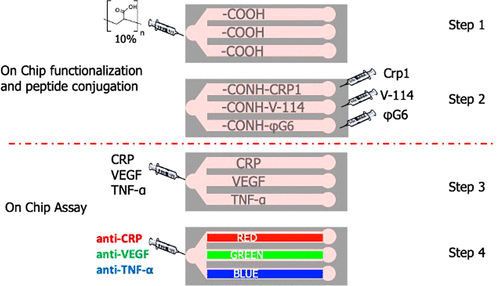当前位置:
X-MOL 学术
›
Bioconjugate Chem.
›
论文详情
Our official English website, www.x-mol.net, welcomes your
feedback! (Note: you will need to create a separate account there.)
Easy Surface Functionalization and Bioconjugation of Peptides as Capture Agents of a Microfluidic Biosensing Platform for Multiplex Assay in Serum
Bioconjugate Chemistry ( IF 4.0 ) Pub Date : 2021-06-11 , DOI: 10.1021/acs.bioconjchem.1c00146 Concetta Di Natale 1, 2 , Edmondo Battista 1, 2 , Vincenzo Lettera 1, 3 , Narayana Reddy 1 , Gabriele Pitingolo 1 , Raffaele Vecchione 1 , Filippo Causa 1, 2, 4 , Paolo Antonio Netti 1, 2, 4
Bioconjugate Chemistry ( IF 4.0 ) Pub Date : 2021-06-11 , DOI: 10.1021/acs.bioconjchem.1c00146 Concetta Di Natale 1, 2 , Edmondo Battista 1, 2 , Vincenzo Lettera 1, 3 , Narayana Reddy 1 , Gabriele Pitingolo 1 , Raffaele Vecchione 1 , Filippo Causa 1, 2, 4 , Paolo Antonio Netti 1, 2, 4
Affiliation

|
The development of assays for protein biomarkers in complex matrices is a demanding task that still needs implementation of new approaches. Antibodies as capture agents have been largely used in bioassays but their low stability, low-efficiency production, and cross-reactivity in multiplex approaches impairs their larger applications. Instead, synthetic peptides, even with higher stability and easily adapted amino acid sequences, still remain largely unexplored in this field. Here, we provide a proof-of-concept of a microfluidic device for direct detection of biomarker overexpression. The multichannel microfluidic polydimethylsiloxane (PDMS) device was first derivatized with PAA (poly(acrylic acid)) solution. CRP-1, VEGF-114, and ΦG6 peptides were preliminarily tested to respectively bind the biomarkers, C-reactive protein (CRP), vascular endothelial growth factor (VEGF), and tumor necrosis factor-alpha (TNF-α). Each PDMS microchannel was then respectively bioconjugated with a specific peptide (CRP-1, VEGF-114, or ΦG6) to specifically capture CRP, VEGF, and TNF-α. With such microdevices, a fluorescence bioassay has been set up with sensitivity in the nanomolar range, both in buffered solution and in human serum. The proposed multiplex assay worked with a low amount of sample (25 μL) and detected biomarker overexpression (above nM concentration), representing a noninvasive and inexpensive screening platform.
中文翻译:

肽的简单表面功能化和生物共轭作为微流控生物传感平台的捕获剂,用于血清中的多重检测
开发复杂基质中蛋白质生物标志物的检测方法是一项艰巨的任务,仍然需要实施新方法。抗体作为捕获剂已广泛用于生物测定,但其稳定性低、生产效率低以及多重方法中的交叉反应性损害了其更大的应用。相反,合成肽即使具有更高的稳定性和易于调整的氨基酸序列,在该领域仍然很大程度上未被探索。在这里,我们提供了用于直接检测生物标志物过度表达的微流体装置的概念验证。多通道微流体聚二甲基硅氧烷(PDMS)装置首先用PAA(聚丙烯酸)溶液衍生化。初步测试CRP-1、VEGF-114和ΦG6肽分别与生物标志物C反应蛋白(CRP)、血管内皮生长因子(VEGF)和肿瘤坏死因子-α(TNF-α)结合。然后,每个PDMS微通道分别与特定肽(CRP-1、VEGF-114或ΦG6)生物缀合,以特异性捕获CRP、VEGF和TNF-α。利用这种微型装置,可以在缓冲溶液和人血清中建立具有纳摩尔范围灵敏度的荧光生物测定。所提出的多重检测使用少量样品(25 μL)并检测到生物标志物过度表达(高于 nM 浓度),代表了一种非侵入性且廉价的筛选平台。
更新日期:2021-08-19
中文翻译:

肽的简单表面功能化和生物共轭作为微流控生物传感平台的捕获剂,用于血清中的多重检测
开发复杂基质中蛋白质生物标志物的检测方法是一项艰巨的任务,仍然需要实施新方法。抗体作为捕获剂已广泛用于生物测定,但其稳定性低、生产效率低以及多重方法中的交叉反应性损害了其更大的应用。相反,合成肽即使具有更高的稳定性和易于调整的氨基酸序列,在该领域仍然很大程度上未被探索。在这里,我们提供了用于直接检测生物标志物过度表达的微流体装置的概念验证。多通道微流体聚二甲基硅氧烷(PDMS)装置首先用PAA(聚丙烯酸)溶液衍生化。初步测试CRP-1、VEGF-114和ΦG6肽分别与生物标志物C反应蛋白(CRP)、血管内皮生长因子(VEGF)和肿瘤坏死因子-α(TNF-α)结合。然后,每个PDMS微通道分别与特定肽(CRP-1、VEGF-114或ΦG6)生物缀合,以特异性捕获CRP、VEGF和TNF-α。利用这种微型装置,可以在缓冲溶液和人血清中建立具有纳摩尔范围灵敏度的荧光生物测定。所提出的多重检测使用少量样品(25 μL)并检测到生物标志物过度表达(高于 nM 浓度),代表了一种非侵入性且廉价的筛选平台。











































 京公网安备 11010802027423号
京公网安备 11010802027423号